TYPO3 extension Cookieman¶
A GDPR tracking consent popup. It asks for approval to include tracking objects (cookies, images or any HTML) and includes the objects when consented. It enables tracking from the very first page (including referrer). Consents are shown in groups and saved to a cookie. It provides a stable API to read out consents with JavaScript.
Demo¶
You can click around the 3 included demo themes here. Have a look at the JavaScript console to see when tracking gets enabled. You can also try out the “Do-not-track” setting of your browser which triggers a message inside the popup (in the “marketing” group) when enabled.
When is it shown?¶
If consent has not been saved yet (aka our cookie CookieConsent is not set) the popup/banner is shown. Exceptions are imprint and data privacy statement pages - this is to follow the GDPR’s expectation that those pages shall be easily and directly accessible and should not interfere with a cookie consent banner.
Browser support¶
IE11 and up, fully responsive
Steps to implement¶
Find out which tracking objects are used¶
You can check your page with an empty cookie storage with your browser and see which cookies gets inserted in your browser. Or you can use a service like https://www.cookieserve.com/ to fetch a page or sign up for services that crawl your whole site regularly for cookies.
There might be connections made to external servers to access tracking pixels or other content that warrant a user consent, too. This applies to youtube (use youtube-nocookie.com) and CDNs (Google Fonts, Bootstrap and other frontend libraries - recommendation: do not use external connections at all if not necessary). Also other means for tracking might be used, like HTML5 Web Storage (localStorage). It is a task for the official Data Security Officer of the site to decide what needs to be consented. If done correctly, you should be able to find a note about used tracking services in the Data Privacy Statement of the site.
If you have control over how the tracking object is inserted you can have cookieman handle that for you. Otherwise you can make the actual inclusion of the tracking object dependant on a cookieman-API-call or a presence of a certain string in cookieman’s cookie “CookieConsent” - this is recommended if you are managing several tags with Google TagManager (set its trigger to “cookie ‹CookieConsent› contains ‹group name, e.g. ”marketing”›).
Install cookieman¶
Requirements¶
- If you reimplement your own theme, it has no requirements at all
- for the example themes
- Bootstrap 3/4 CSS
- Bootstrap 3/4 JavaScript for collapses and modals
- jQuery
Installation¶
Get it from packagist https://packagist.org/packages/dmind/cookieman via composer
… or download it from https://extensions.typo3.org/extension/cookieman/.
Each version only supports either TYPO3v8/v9/v10. This might be a bit confusing but makes development and testing easier.
Integration¶
Include the shipped TypoScript as usual (either by including it from a sys_template [“Cookieman”] or by referencing the files from your site package).
TypoScript constants¶
Adjust the TypoScript constants (again, either in a sys_template record or in a file in your site package):
plugin.tx_cookieman.settings. …
resourcesBasePath: String (default: EXT:cookieman/Resources)¶
see below (“Create new theme”) - the default enables the shipped demo themes
theme: String (default: bootstrap4-modal)¶
the theme name. These default themes are shipped:
bootstrap3-banner:
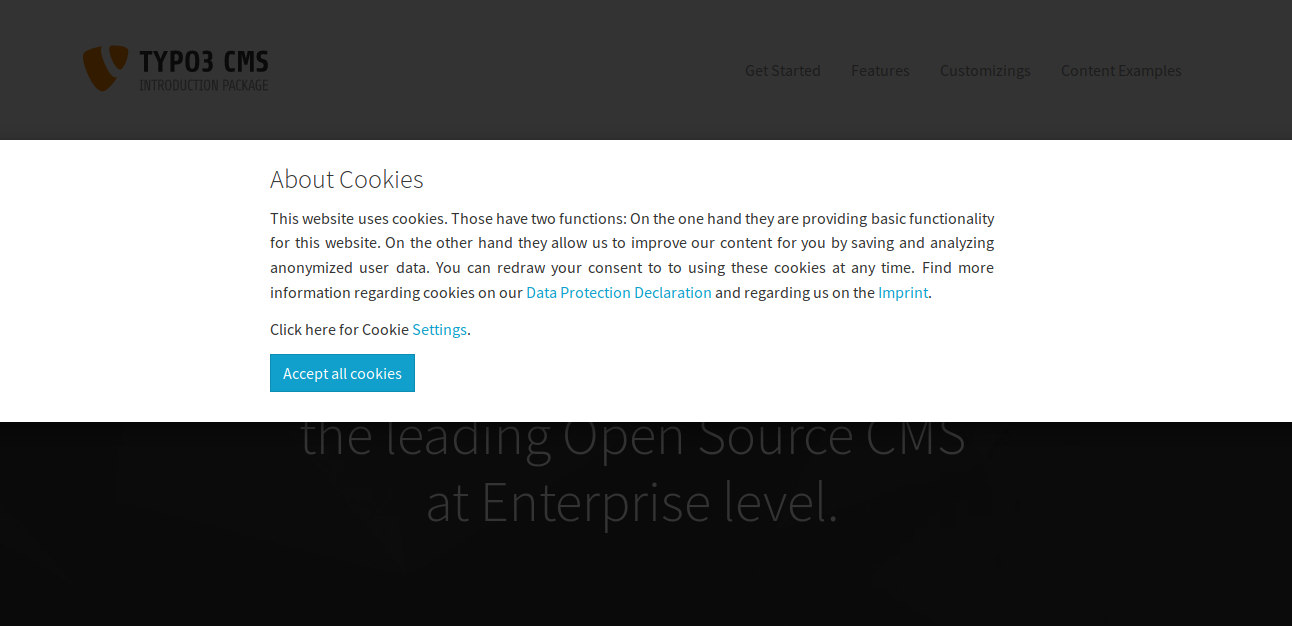
bootstrap3-banner
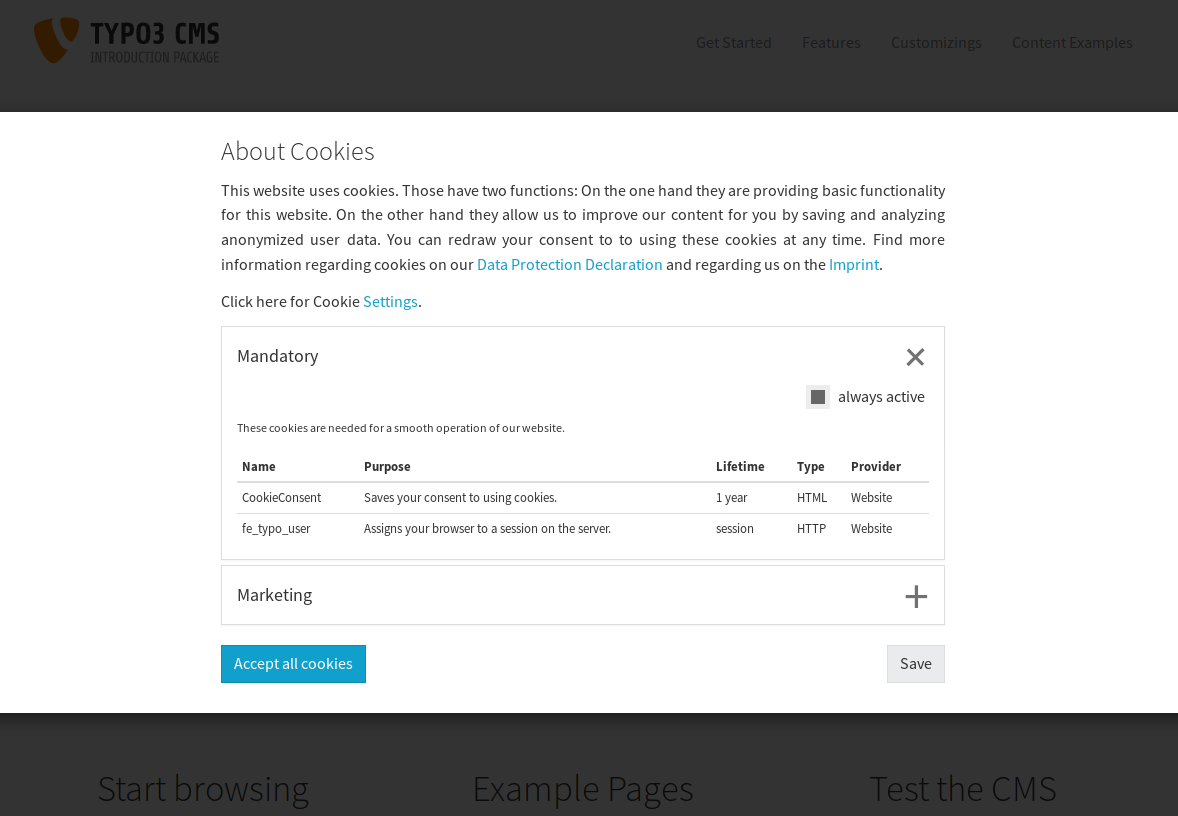
bootstrap3-banner
bootstrap3-modal:
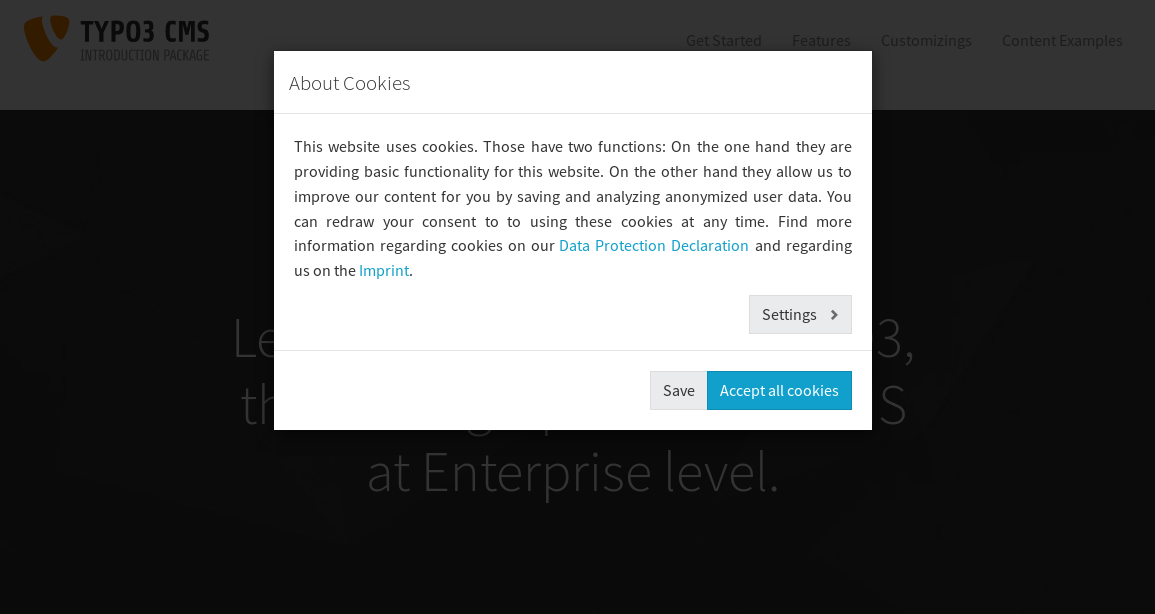
bootstrap3-modal
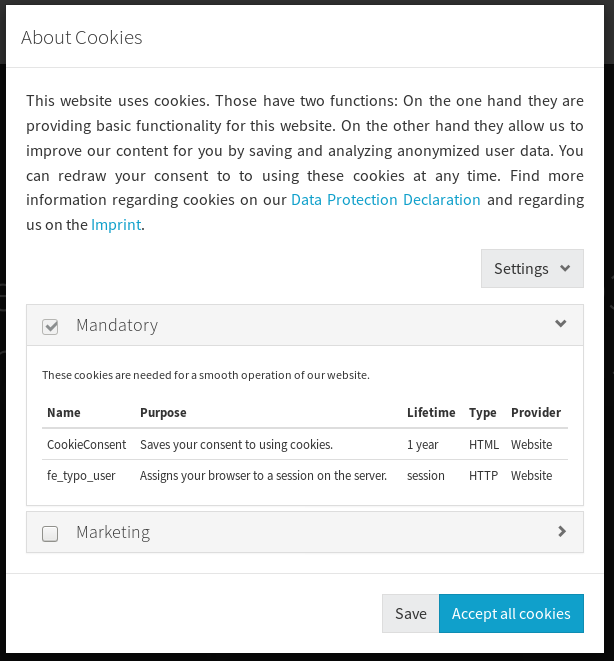
bootstrap3-modal
bootstrap4-modal:
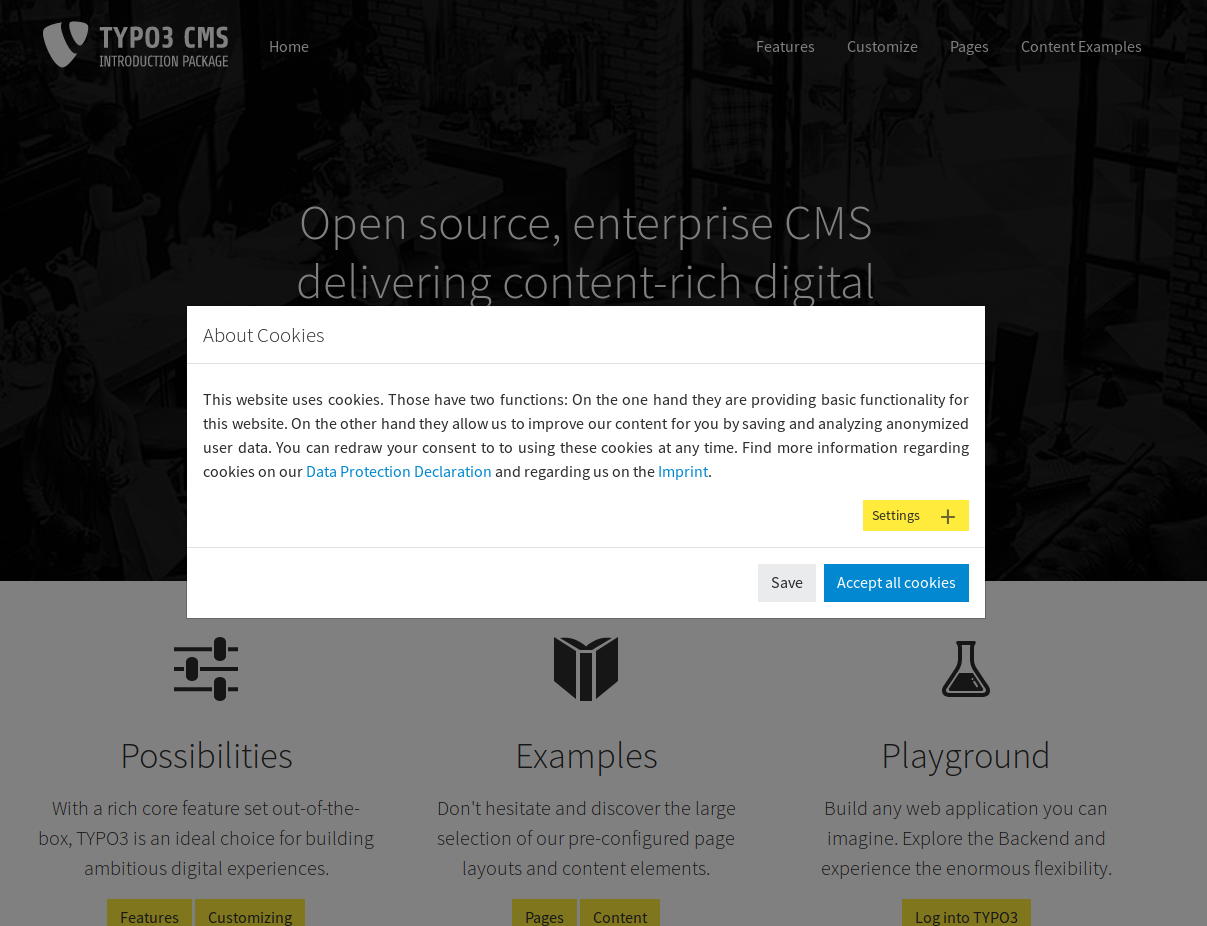
bootstrap4-modal
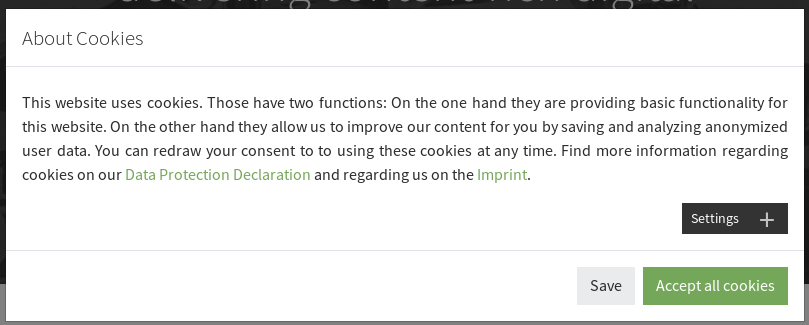
bootstrap4-modal
links.dataProtectionDeclarationPid: int¶
page UID of data privacy statement page - the cookieman modal will not be automatically opened on this page (See “When is it shown?”)
links.dataProtectionDeclarationAnchor: ?String¶
an anchor (TYPO3-lingua “section”) on that page, if needed
links.imprintPid: int¶
page UID of imprint page - the cookieman modal will not be automatically opened on this page (See “When is it shown?”)
links.imprintAnchor: ?String¶
an anchor (TYPO3-lingua “section”) on that page, if needed
minify: int(0,1) (default: 1)¶
If 1, includes the minified versions of .css and .js
TypoScript setup¶
See a full TypoScript configuration example below.
plugin.tx_cookieman.settings. …
groups: Array (default: example groups - you should override that, see below for a full TypoScript example)¶
holds the group configurations. A group contains several tracking objects.
groups.‹group key›: Array¶
a single group. The key should not contain spaces and non-ASCII characters. It will be saved in the settings cookie and can be checked with JavaSript: hasConsented(‘‹group key›’)
groups.‹group key›.preselected: int(0,1)¶
If 1, the groups consent checkbox will be already checked when the popup opens.
groups.‹group key›.disabled: int(0,1)¶
If 1, the checkbox will be disabled (cannot be changed)
groups.‹group key›.trackingObjects: Array¶
holds a list of tracking object keys
Example:
groups.‹group key›.respectDnt: int(0,1)¶
If 1, this group pays respect to the “Do-not-track” setting of the browser.
groups.‹group key›.showDntMessage: int(0,1)¶
If 1 AND the “Do-not-track” setting of the browser is enabled, a message about that is shown.
trackingObjects: Array (default: example tracking objects, you can use them, but override its .inject)¶
holds the tracking object configurations. Have a look at the included examples here https://github.com/dmind-gmbh/extension-cookieman/tree/master/Configuration/TypoScript/TrackingObjects
trackingObjects.‹tracking object key›: Array¶
a single tracking object configuration
trackingObjects.‹tracking object key›.inject: String¶
everything in here will be appended to the page when the respective group is consented. This can be <script>, <img> or anything else
trackingObjects.‹tracking object key›.show: Array¶
the actual rows of the table, each representing one “tracking item” (commonly a cookie)
trackingObjects.‹tracking object key›.show.‹tracking item key›: Array¶
a single “tracking item”
trackingObjects.‹tracking object key›.show.‹tracking item key›.duration: int¶
the lifetime (only the “number” part)
trackingObjects.‹tracking object key›.show.‹tracking item key›.durationUnit: String¶
the lifetime (only the “unit” part) - e.g. “months”
trackingObjects.‹tracking object key›.show.‹tracking item key›.type: String¶
the type of tracking:
“cookie_http+html”: an HTML (=HTTP+HTML) cookie which is also readable from JavaScript
“cookie_http”: an HTTP cookie
You can add your own types by adding a localization string “type.‹you type key›”
trackingObjects.‹tracking object key›.show.‹tracking item key›.provider: String¶
the provider, e.g. Google
Translation¶
All strings are translatable. Translations are managed on Crowdin:
. Click the button to help translating!
You can override translations by the usual means (.xlf-files or TypoScript *_LOCAL_LANG*, see below for an example).
If you have added groups or tracking objects, you will have to add these translation strings:
group.‹group key›¶
shown as group title
group.‹group key›.desc [optional]¶
shown as introductory text block above the table
trackingobject.‹tracking object key›.desc¶
shown in the table column “Purpose”
Make the consent revokable¶
It is recommended to include a snippet like the following on your data privacy statement page to allow your users to adjust their cookie preferences:
TypoScript configuration example (setup part):¶
Create a new theme or adapt an existing one¶
We are happy to receive pull-requests for new themes!
This is a recommendation how to set up your template structure for a custom extension. It looks like this: https://github.com/dmind-gmbh/extension-cookieman/tree/master/Build/cookieman_test_customtheme.
Set your base path in TypoScript constants:
Choose a new theme name:
Create folder
EXT:your_ext/Extensions/cookieman/Resources/Private/Themes/myTheme/.
Add 3 folders: Templates, Partials, Layouts.
These folders will have the highest priority when looking for templates,
partials or layouts now. The fallback will be
EXT:cookieman/Resources/Private/*.
Create folder
EXT:your_ext/Extensions/cookieman/Resources/Public/Themes/myTheme.
This will hold the files cookieman-theme(.min).css and
cookieman-theme(.min).js. Reimplement the methods cookieman.show()
and cookieman.hide() in cookieman-theme(.min).js.
Copy the .css, .js and .html files as needed from a default theme.
Adapt the HTML/CSS/JS as needed.
These HTML attributes elements control the functionality: #### <* data-cookieman-save> > save and close #### <* data-cookieman-accept-all> > mark all checkboxes
They can appear multiple times and also together on the same element.
API¶
cookieman.js exposes these methods:
Shows the confirmation modal when consent has not been saved yet. It is automatically called on each page fromcookieman-init.js(with an aditional condition, see “When is it shown?”).
Shows the confirmation modal. You can call that from anywhere you need it (e.g. with a link from your data protection declaration page).
Hides the confirmation modal.
Returns true if the user has consented to the given selection, else false. A selection is any name of a checkbox in the popup, e.g. ‘marketing’
Cookieman also includes the (1kB) cookie library JavaScript Cookie that also exposes its API and makes it easier to work with cookies.
Development¶
Choose your branch: 8lts (TYPO3 8.7), 9lts (TYPO3 9.5), master (TYPO3 10.x).
To try it: just run ddev start which will install a TYPO3 with
example content and cookieman. This installs helper extensions that
automatically enable a certain theme and some TypoScript setup to
facilitate development. The admin user is “admin”, password
“adminadmin”.
After switching branches, you might need a
git clean -fdX -e '!.idea'.
To throw away the database and restart cleanly, run
ddev rm -ORU && git clean -fdX -e '!.idea' && ddev start
ddev install-git-hooks will install the CGL tools as a pre-commit
hook.
Contact¶
For bugs and feature requests use the Github bug tracker.
Pull requests are very welcome.
Private messages: projekt-cookieman@d-mind.de

